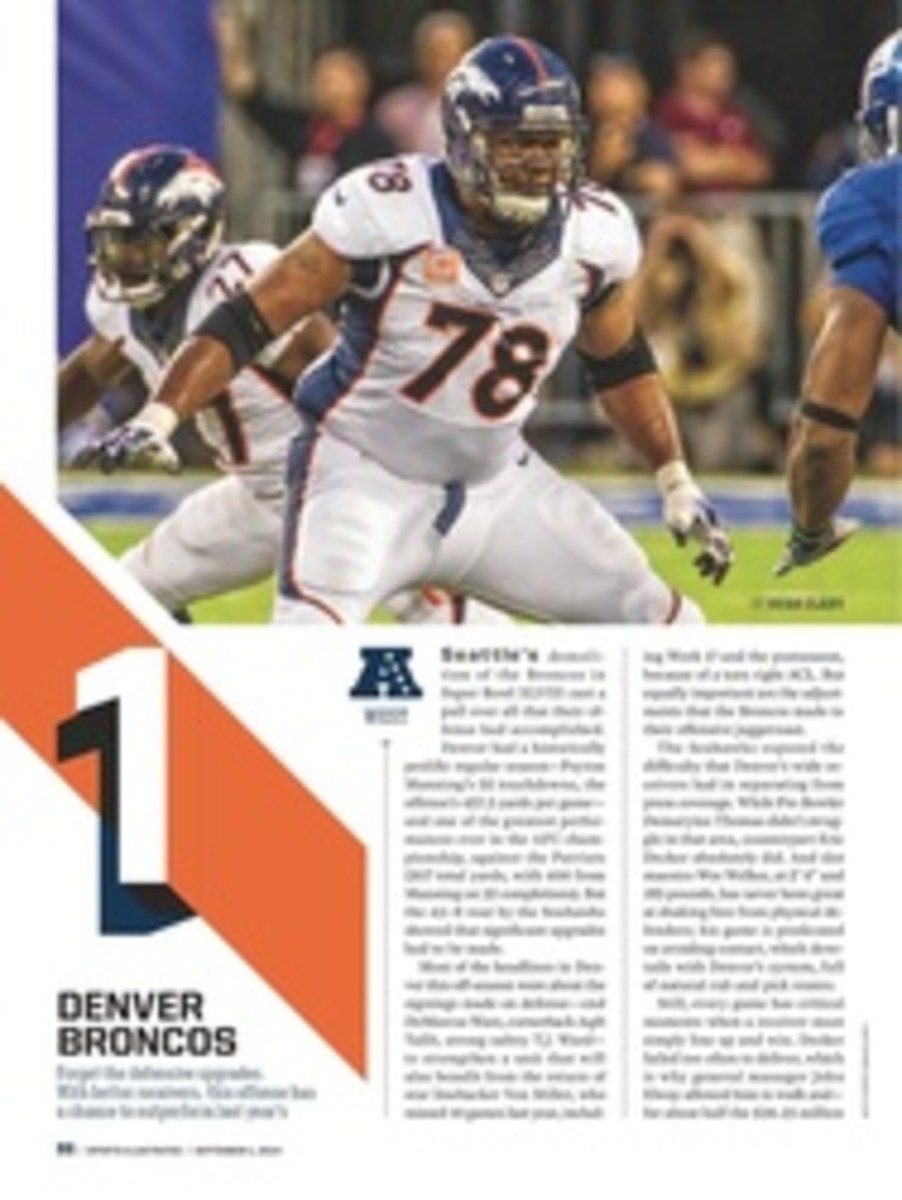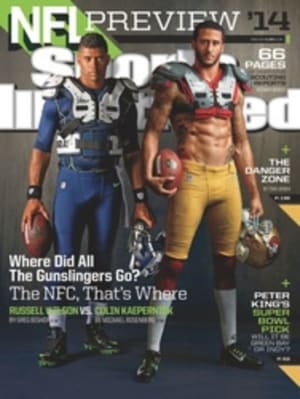
3 BUFFALO BILLS
Fresh off a third consecutive six-win season and trying to avoid a 10th straight sub-.500 campaign, the Bills had one goal entering the opening night of this year's draft: Clemson wideout Sammy Watkins. After failing to trade up with the Texans for the No. 1 pick, GM Doug Whaley swung a deal with the Browns and got Watkins at No. 4. The price: the ninth choice, plus Buffalo's first- and fourth-rounders in 2015.
Mortgaging the future was easy for the second-year GM; with the looming sale of the franchise following owner Ralph Wilson Jr.'s death in March, it's no guarantee that anyone from the front office—or from second-year coach Doug Marrone's staff—will be in Buffalo past 2014. The surest way to obtain job security: win immediately.
The last team to surrender a bounty of draft choices to select a blue-chip receiver was the 2011 Falcons, who sent the Browns—yep, them again—two first-round picks, plus a second-rounder and two fourth-rounders to get Julio Jones. But the Bills' situation isn't comparable. Atlanta was one receiver away from Super Bowl contention. Buffalo? This club was one receiver away from mere offensive respectability.
A fair question at this point is, Can a lone receiver really carry an offense? The NFL has become a passing league, sure, but the GM with whom Whaley made the trade for Watkins, Cleveland's Ray Farmer, made an interesting point in May when word got out about the yearlong suspension of his own Sammy Watkins, Josh Gordon. "Name the last big-time receiver to win a Super Bowl," Farmer said. "The last guy that really helped his team get there was T.O."—Terrell Owens, with the 2004 Eagles.
Sure, Farmer was speaking out of self-interest. But many offenses today succeed with good-but-not-great receivers who can get open strictly through cunning play design. What Farmer did not acknowledge, however, is that most teams that reach the Super Bowl with such wideouts still have a big-time quarterback. And while the Bills have solid receivers alongside Watkins—jump-ball snagger Mike Williams, crisp route runner Robert Woods and backup speedsters T.J. Graham and Marquise Goodwin—they don't exactly have a Pro Bowl gunslinger distributing the ball.
Second-year starter EJ Manuel is still developing proper footwork and pocket poise. Those skills are vital to improving his accuracy, which last year suffered drastically the farther he had to throw. Intelligent as he is, Manuel is not near being able to reel off first downs with presnap adjustments or sharp postsnap recognition. And for those reasons, Marrone's three-receiver hurry-up system could continue its painful simplicity in 2014.
Buffalo will be an excellent case study in whether raw receiving talent alone can elevate a callow QB and a rudimentary system. The 50-year-old Marrone, known as an old-school O-line coach, was hired in large part because of his impressive midseason switch to a spread system at Syracuse in 2012. He has the personnel to spread out again in '14, not just because of his capable receivers but also because of two excellent pass catchers out of the backfield: C.J. Spiller, who has the lateral agility to create space, including when he lines up out wide; and Fred Jackson, who operates proficiently inside, particularly on screens.
Injuries, however, have been an issue for both backs. And though the Bills have a line capable of moving bodies in the ground game—especially after the drafting of tackles Cyrus Kouandjio (Alabama) and Seantrel Henderson (Miami), and given the continued dependability of center Eric Wood—Marrone's best chance at instant success is to lean on his young receivers to carry the spread. It's a system in which the simplification goes both ways: It's easy for a defense to figure out, but it also makes that defense easier to decipher. The spread's spacing creates difficulties for safeties and linebackers when it comes to disguising coverages, and Manuel will benefit from those predictable looks as he works to become a more proficient drop-back passer.
At least Buffalo's defense is on the upswing—even if it will have to overcome the departure in free agency of Pro Bowl safety Jairus Byrd (Saints) and a season-ending left-ACL injury to linebacker Kiko Alonso this summer. Third-year cornerback Stephon Gilmore is on track for superstardom, and there's a reasonable optimism that defensive ends Mario Williams and Jerry Hughes can again reach double-digit sack totals in Buffalo's new 4--3 zone system.
The soundest way to hide a developing quarterback is to win on the other side of the ball. Even with a game-breaker like Watkins, the Bills' defense needs to do that big-time in 2014.
2014 SCHEDULE
2013 Record: 6--10
WEEK 1
CHI [AWAY]
MIA [HOME]
SD [HOME]
HOU [AWAY]
DET [AWAY]
NE [HOME]
MIN [HOME]
NYJ [AWAY]
BYE
KC [HOME]
MIA THUR [AWAY]
NYJ [HOME]
CLE [HOME]
DEN [AWAY]
GB [HOME]
OAK [AWAY]
NE [AWAY]
WEEK 17
FOCUS ON
The defensive tackles
Despite finally receiving Pro Bowl honors in 2010 (and again in '12 and '13), 6'1", 303-pound Kyle Williams still labors under many fans' radar. He shouldn't. With a mastery of leverage and remarkable initial quickness, Williams, 31, is one of the league's few every-down forces at defensive tackle—and an excellent fit in new coordinator Jim Schwartz's 4--3 scheme, which depends on gap-shooting penetration off the ball. That scheme should also energize Williams's linemate, Marcell Dareus, who despite myriad off-field issues enters the season with an opportunity to exhibit the talent that got him drafted No. 3 out of Alabama in '11. The 6'3", 331-pound Dareus was often asked to hold ground against double teams in the Bills' previous system, but he excels when he can use his finesse to shed blocks in moving out of congested areas. And that's what Schwartz will have him do, even from a nose-shade position.
THE CASE FOR
Cornerback Stephon Gilmore
You may not have heard much about the Bills' 2012 first-round pick from South Carolina, but barring injuries—like the broken left wrist that sidelined him for five games last season—Gilmore will become a top three corner in '14. That is, if he's used properly. Coordinator Jim Schwartz, known for his zone-oriented system, must be willing to use the physical, lanky Gilmore as a press-man corner, the way Pete Carroll has used Richard Sherman in Seattle. Gilmore, like Sherman, is a tremendous boundary defender, but given his extreme athleticism, he doesn't need to operate almost exclusively on the same side of the field, the way Sherman is used. He most likely will, though, as the Bills have a talented corner opposite him in Leodis McKelvin. Plus, they're set in the slot. Buffalo native Corey Graham was signed in free agency after emerging as a solid slot defender in Baltimore—a surprising acquisition because undrafted rookie Nickell Robey flourished last year as a man-to-man corner and slot blitzer. That quartet of talent at corner, led by Gilmore, helps offset the loss of free safety Jairus Byrd and could propel this defense to a second straight top 10 ranking.
PHOTO
GRANT HALVERSON/GETTY IMAGES
WR SAMMY WATKINS
PHOTO
MARK LOMOGLIO/ICON SMI
NINTEEN PHOTOS

